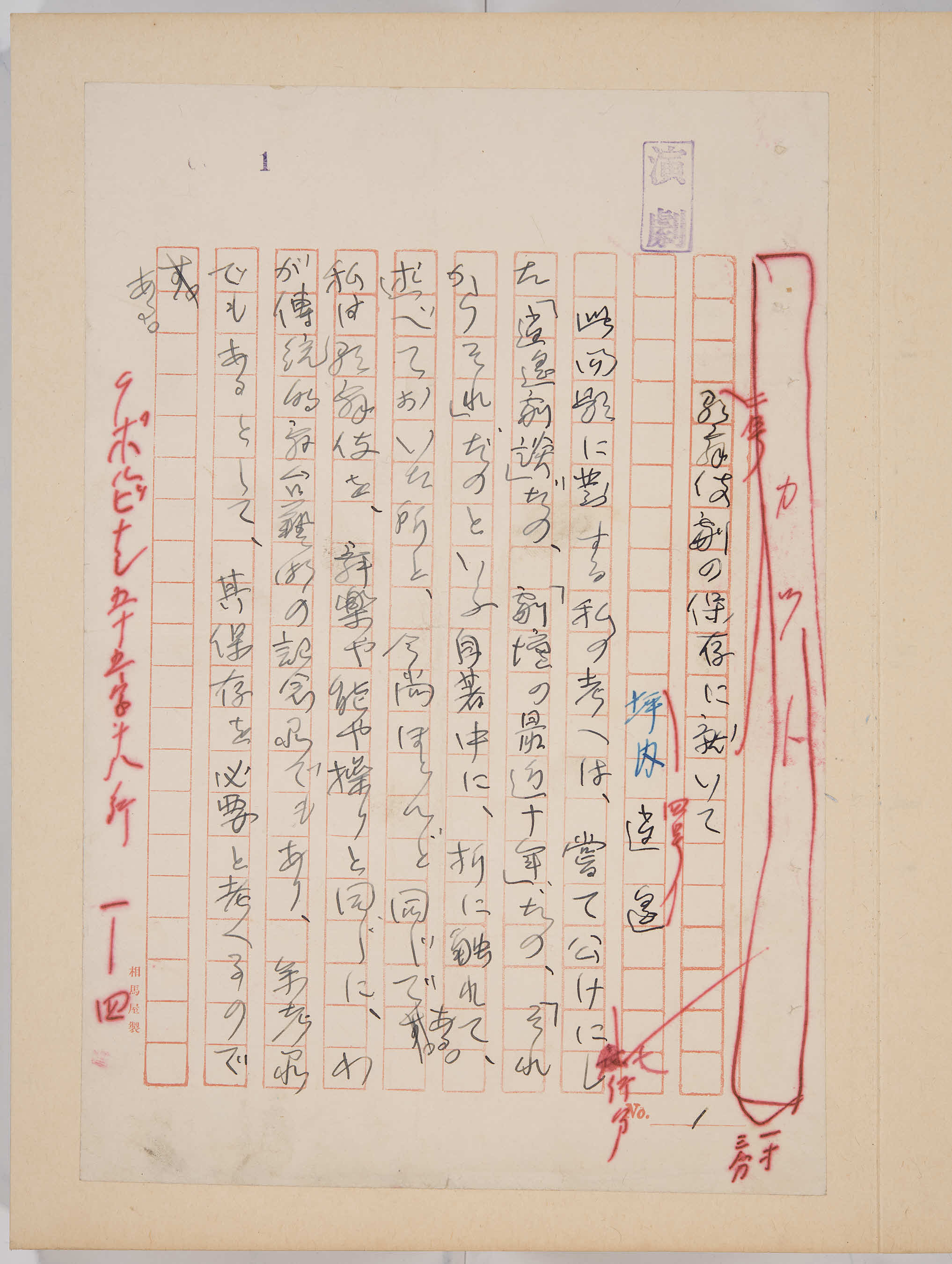-

-
Title in English: On the Preservation of Kabuki Drama
Author: Tsubouchi, Shōyō 坪内逍遥, 1859-1935
Imprint: [Autograph] 1924Quote from book: 私は歌舞伎を、舞楽や能や操りと同じにわが伝統的舞台術の記念品でもあり、参考品でもあるとして、其保存を必要と考えるのである。〈略〉けれども保存の可能不可能は保存の必要不必要とは別問題である。苟も保存を必要と認めた以上は、無理にも何等かの法を講じてそれをして可能ならしめねばならぬ。
Quote translated from book: "I believe that like bugaku, nō, and the puppet theater, kabuki needs to be preserved as a memento and specimen of our traditional stage arts. ... Yet the question of whether something can or cannot be preserved is separate from the question of whether something ought to be preserved. Supposing we agree that preservation is necessary, then we must devise some means of accomplishing that even if it is difficult."
Description: Shōyō wrote the manuscript "On the Preservation of Kabuki Drama" in late March 1924 at the request of Yamamoto Yūzō, the editor of Engeki shinchō, and the essay was published in the journal in June of that year. In his essay, Shōyō addresses what had become for him, by the 1920s, a seminal problem: kabuki was treated as a single art (like nō theater) but, Shōyō felt, the dramatic form had changed significantly over time, from its origins in the early seventeenth century through the early twentieth century. Thus before one could address how to preserve kabuki one needed to determine which aspects of the dramatic art ought be persevered as most representative. Shōyō's own stance was clear: the "zenith" of the art was in the late eighteenth century and what followed - from the early nineteenth century onward - was a gradual decay. Thus preservation was perhaps not the right word since what Shōyō sought was really to revive the form of kabuki that had disappeared already over a century earlier.
Shōyō had developed an interest in questions related to the preservation (hozon) of kabuki in the late 1880s and it would remain a concern across his career as playwright, critic, and historian of drama. And yet the timing of "On the Preservation of Kabuki Drama" is also interesting from a historical perspective. The piece was written just six months after the Great Kantō Earthquake destroyed large sections of the city of Tokyo and many writers - Akutagawa Ryūnosuke chief among them - lamented the loss of cultural heritage that resulted from the earthquake and resulting fires. When the earthquake hit on September 1, 1923, Shōyō was at Waseda University in a meeting with Takata Sanae, the University's president, discussing an exhibition of theater material that was to be held in October. Within days of the earthquake, Shōyō had decided to donate his own private collection of books and theater ephemera to Waseda, the university at which he had taught his entire career. In 1928, with the help of students, friends, and the university, Shōyō was able to realize his long-term goal of creating a theater museum on the campus of Waseda University. The Museum was intended "preserve, as a form of history, Japan's theater which is incomparable in form in the world and which has developed along a unique path." Thus while Shōyō may not have achieved his idea of preserving kabuki of the late eighteenth century as a living dramatic art, today the Waseda University Tsubouchi Memorial Theater Museum plays a critical role in preserving the history of kabuki through an unparalleled collection of archival materials. (By Jonathan Zwicker)
-
関連記事
B2.1 歌舞伎劇の保存に就いて Kabukigeki no hozon ni tsuite

![R1 当世書生気質挿画下絵 : [池の端の出会ひ]](http://archive.wul.waseda.ac.jp/kosho/bunko14/bunko14_b0066/bunko14_b0066_p0002.jpg)